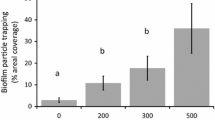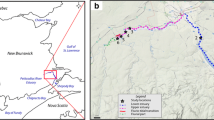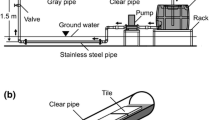Abstract
The observation that deposits of fine sediment are found on stream beds only in areas of slower water velocity promotes a common misunderstanding of the depositional behaviour of fine suspensoids in flowing water and a disregard for the potential for siltation effects on the biota on the surface of stones in fast flowing water. A model for deposition from turbulent water, whereby particles are lost from suspension where water currents are slowed by boundary friction, provides an explanation for silt infiltration into epilithic periphyton. Theoretically calculated deposition rates of clay sized mineral particles at low suspended concentrations (2 to 5 g m−3) were found to account for observed rates of silt accumulation in epilithic periphyton in a braided river in the South Island of New Zealand. At concentrations between 1 and 10 g m−3 of suspended mineral silt during normal flow, silt accumulation in epilithic periphyton accounted for about 50% of its dry weight. This caused a reduction in the mean organic content of the periphyton to 22% of the dry weight compared to 52% in a reference stream where the concentration of suspended mineral particles was less than 1.0 g m−3 during non-freshet flow. This reduction in proportional organic content is discussed in terms of diminished food value of the periphyton and potential interactions between periphyton and invertebrate consumers.
Similar content being viewed by others
References
American Public Health Assiciation, 1981. Standard Methods for the Analysis of Water and Wastewater, 15th Ed., American Public Health Association, Inc., Washington, D. C.
Alabaster, J. S. & R. L. Lloyd, 1982. Water Quality Criteria for Freshwater Fish. 2nd Ed. Butterworths, London. 361 pp.
Anderson, N. H. & K. W. Cummins, 1979. Influences of diet on the life histories of aquatic insects. J. Fish. Res. Bd Can. 36: 335–342.
Bott, T. L., 1983. Primary production in streams. pp. 29–54 in: Barnes, J. R. & G. Wayne Minshall (eds), Stream Ecology, Application and Testing of General Ecological Theory. Plenum Press, N. Y., 399 pp.
Carling, P. A., 1984. Deposition of fine and coarse sand in open work gravel bed. Ca. J. Fish. aquat. Sci. 41: 263–270.
Cline, L. D., R. A. Short & J. V. Ward, 1982. The influence of highway construction on the macroinvertebrates and the epilithic algae of a high mountain stream. Hydrobiologia 96: 149–159.
Cushing, C. E., 1967. Periphyton productivity and radionuclide accumulation in the Columbia River, Washington, USA. Hydrobiologia 29: 125–139.
Draper, N. R. & H. Smith, 1981. Applied Regression Analysis. John Wiley & Sons, N. Y., 709 pp.
Einstein, H. A., 1968. Deposition of suspended particles in a gravel bed. J. Hydraul. Div. Am. Soc. Civil Eng. 94: 1197–1205.
Eloranta, P. & S. Kunnas, 1979. The growth and species communities of the attached algae in a river system in Central Finland. Arch. Hydrobiol. 86: 27–44.
Folk, R. L., 1980. Petrology of Sedimentary Rocks. Hamphill Publishing Co., Austin, Texas.
Graham, A. A., 1989. The effects of siltation and flow characteristic on the productivity and composition of lotic periphyton. Ph. D. dissertation, University of Otago, Dunedin, New Zealand.
Graham, A. A., D. J. McCaughan and F. S. McKee, 1988. Measurement of surface area of stones. Hydrobiologia 157: 85–7.
Gregory, S. V., 1983. Plant-herbivore interactions instream ecosystems. pp. 157–190 in: Barnes, J. R. & G. Wayne Minshall (eds), Stream Ecology, Application and Testing of General Ecological Theory Plenum Press, N. Y., 399 pp.
Hawkins, C. P., 1986. Variation in individual growth rates and population densities of ephemerellid mayflies. Ecology 67: 1384–1395.
Hoagland, K. D., S. C. Roemer & J. R. Rosowski, 1982. Colonisation and community structure of two periphyton assemblages, with emphasis on the diatoms (Bacillariphyceae). Am. J. Bot. 69: 188–213.
Horner, R. R., E. B. Welch & R. B. Veenstra, 1983. Development of nuisance periphyic algae in laboratory streams in relation to enrichment and velocity. Hydrobiologia/Dev. Hydrobiol. 17: 121–131.
Horner, R. R. & E. B. Welch, 1981. Stream periphyton development in relation to current velocity and nutrients. Can. J. Fish. aquat. Sci. 38: 449–457.
Jowett, I. G., 1984. Lower Waitaki catchment hydrology report. New Zealand Ministry of Works and Development, Wellington. Investigations Report No. 84/5, 107 pp.
Lamberti, G. A. & J. W. Moore, 1984. Aquatic insects as primary consumers. pp. 164–195 in: Resh, V. H. & D. M. Rosenberg, (eds), The Ecology of Aquatic Insects. Praeger Publishers, N. Y.
Li, R-M. & H. W. Shen, 1975. Solid particle settlement in open channel flow. Journal of the Hydraulics Division, ASCE, HY7: 917–930.
Lloyd, D. S., J. P. Koenings & J. D. LaPerrierre, 1987. Effects of turbidity in fresh waters of Alaska. North America Journal of Fisheries Management 7: 18–33.
McCave, I. N., 1970. Deposition of fine-grained suspended sediment from tidal currents. J. geophys. Res. 75: 4151–4159.
McCave, I; N., 1984. Erosion, transport and deposition of fine-grained marine sediments. pp. 35–70 in: Stow, D. A. & D. J. W. Piper (eds), Fine-grained sediments: deep water processes and facies. Blackwell Scientific Publications, Oxford
Middleton, G. V. & J. B. Southard, 1978. Mechanics of sediment movement. Short course No. 3, Society of Economic Paleontologists and Mineralogists. Birmingham, Y.
Milner, N. J., J. Sculling, P. A. Crisp & D. T. Crisp, 1981. The effects of discharge on sediment dynamics and consequent effects on invertebrates and salmonids in upland rivers. Appl. Ecol. 6: 153–20.
Munteanu, N. & E. J. Maly, 1981. The effect of current on the distribution of diatoms settling on submerged glass slides. Hydrobiologia 78: 273–282.
Murphy, M. L., 1984. Primary production and grazing in freshwater and intertidal reaches of a coastal stream, Southern Alaska. Limnol. Oceangr. 29: 805–815.
Reynolds, C. S., 1979. Seston sedimentation: experiments with Lycopodium spores in a closed system. Freshwat. Biol. 9: 55–76.
Rivier B. & J. Sequier, 1985. Physical and biological effects of gravel extraction in river beds. pp. 131–146 in: Alabaster, J. S., (ed.), Habitat Modification in Freshwater Fisheries. Butterworths, London. 278 pp.
Sartory, D. P. & J. U. Grobbelaar, 984. Extraction of chlorophyll a from freshwater phytoplankton for spectrophotometric analysis. Hydrobiologia 114: 117–187.
Silvester, N. R. & M. A. Sleigh, 1985. The forces on microorganisms at surfaces in flowing water. Freshwat. Biol. 15: 33–448.
Sloane-Richey, J., M. A. Perkins & K. W. Malueg, 1981. The effects of urbanization and stormwater runoff on the food quality in two salmonid streams. Verh. int. Ver. Limnol. 21: 812–818.
Smith, I. R., 1975. Turbulence in Lakes and Rivers. FBA Scientific Publication No. 29, Ambleside, England.
Smith, I. R., 1982. A simple theory of algal deposition. Freshwat. Biol. 12: 445–449.
Stevenson, R. J., 1983. Effects of current and conditions simulating autogenically changing microhabitats on benthic diatom communities Ecology 64: 1514–1524.
Sweeney, B. W., 1984. Factors influencing life-history patterns of aquatic insects. pp. 56–100 in: Resh, V. H. & D. M. Rosenberg (eds), The Ecology of Aquatic Insects. Praeger Publishers, N. Y.
Towns, D. R., 1981. Effects of arificial shading on periphyton and invertebrates in a New Zealand stream. New Zealand J. mar. Freshwat. Res. 15: 185–192.
Van Nieuwenhuyse, E. E. & J. D. LaPerriere, 1986. Effects of placer gold mining on primary production in subarctic streams of Alaska. Wat. Res. Bull. 22: 91–99.
Vogel, S., 1981. Life in moving fluids: The Physical Biology of Flow. Willard Grant Press, Boston.
Whitford, L. A. & G. J. Schumacher, 1961. Effect of current on mineral uptake and respiration by freshwater algae. Limnol. Oceanogr. 6: 423–425.
Whitford, L. A., 1960. The current effect and growth of freshwater algae. Trans. Am. Microscop. Soc. 79: 302–309.
Zalewski, M. & R. J. Naiman, 1985. The regulation of riverine fisheries by a continuum of abiotic-biotic factors. pp. 3–9 in: Alabaster, J. S., (ed.), Habitat Modification in Freshwater Fisheries. Butterworths, London. 278 pp.
Author information
Authors and Affiliations
Rights and permissions
About this article
Cite this article
Graham, A.A. Siltation of stone-surface periphyton in rivers by clay-sized particles from low concentrations in suspention. Hydrobiologia 199, 107–115 (1990). https://doi.org/10.1007/BF00005603
Received:
Revised:
Accepted:
Issue Date:
DOI: https://doi.org/10.1007/BF00005603




